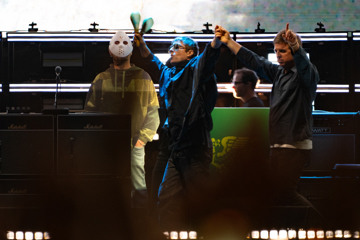Designed By Nature
“Make-up artistry is a passion I have had for many years and I was fortunate to turn it into an exciting career."
Mainstream Australian textile and fashion designers such as Linda Jackson and Jenny Kee have long drawn inspiration from Indigenous culture. But there's also a rich tradition of Indigenous designers. Bronwyn Bancroft, who in the mid-'80s launched the Designer Aboriginals store in Sydney, went on to show her extraordinary fabrics in Paris. In 2014 the inaugural Australian Indigenous Fashion Week will take place in Sydney with Aboriginal supermodel Samantha Harris as its ambassador. Meanwhile, the first major Indigenous Fashion Unearthed runway was held in March during the L'Oreal Melbourne Fashion Festival to a huge response. Now the globally unique show is back for Melbourne Spring Fashion Week, its theme 'Generations'. Significantly, IFU will showcase Indigenous designers from Australia and New Zealand – among them Timmy Smith, Liana Pakinga and Darwin's Lenore Dembski (who's behind the Paperbark Woman line). Football hero Liam Jones will parade his grungy T-shirts. What's more, there will be Indigenous models from across Australia (primarily Aboriginal, but also some from other Indigenous cultures, including Native American) and, backstage, Indigenous make-up artists, hairdressers and stylists. Worawa Aboriginal College students will model their own collection. Opening the event is original Sapphires member – and Aboriginal model – Lois Peeler.
Maori woman Tina Waru, who's worked in health and education, is Co-Founder and Creative Director of the IFU mentorship programme, together with internationally renowned photographer Wayne Quilliam, of Palawa (Aboriginal Tasmanian) heritage. Waru wanted IFU – which, being unfunded, is run by volunteers – to provide Indigenous creatives with an entrepreneurial “platform” and opportunity to network. Most importantly, it presents Indigenous youth with role models and possibilities or, as Waru eloquently puts it, “pathways”. Establishing an Indigenous “presence” in the occasionally “intimidating” fashion industry isn't merely symbolic – it's directly empowering, she says. “It actually changes things for a lot of Indigenous communities because they get to work together – [and] get to work on well-being and confidence.”
One of IFU's emerging designers is Stacie Piper, who'll display couture headpieces. The Melburnian was already a successful make-up artist when she began to seriously assemble accessories. “Make-up artistry is a passion I have had for many years and I was fortunate to turn it into an exciting career,” Piper says. “I am always surrounded by fashion and, being a fashion lover myself, I would make my own small garments, alter old tops, et cetera. I have also worn head jewellery and headbands and would make them out of material, beads, that I personally liked. People would comment on these, so I thought I would create [more] and start sharing them with an audience!” Piper's foray into design was influenced by an examination of her Wurundjeri ancestry in an unlikely setting. “I happened to be invited to the museum to view my ancestors' artefacts. I came across a headband which was woven by my great, great grandmother. It made me realise my love of headbands and creating them must stem from my history, which made me feel very connected to them.” The designs Piper will be showing at IFU relate to the land. “I have taken inspiration from nature for my headpieces in this collection. I think of totems, animals and their messages, elements. I feel the immersion of the feelings I have, the lesson I learn from nature, and the inspiration I draw from my ancestors – particularly my mother who has recently passed away – helps me create and tell a story.”
Piper has her own favourite designers. “I love Linda Jackson for her quirky style and bold use of colour; it reminds me of my mother as she had a very eccentric style. Aron Katona is one of my most favourite, again for his eccentric and brave creations, which are so wearable. [And] I look up to my Elders in the Wurundjeri community who design their [own] jewellery range – their one-of-a-kind pieces come with a special story, Bunjil Creations. These are just too special.”
Don't miss a beat with our FREE daily newsletter






